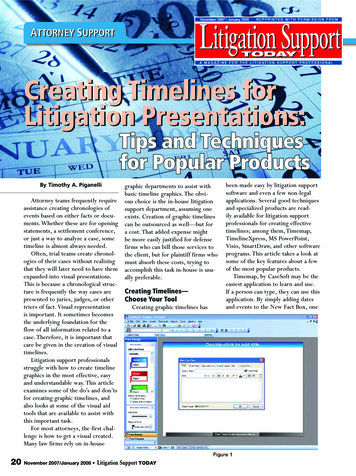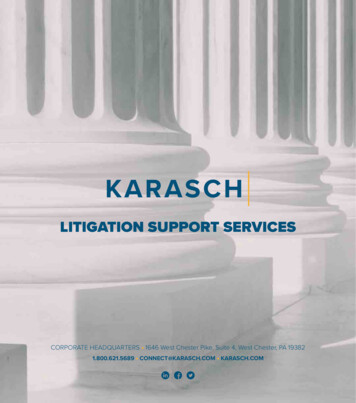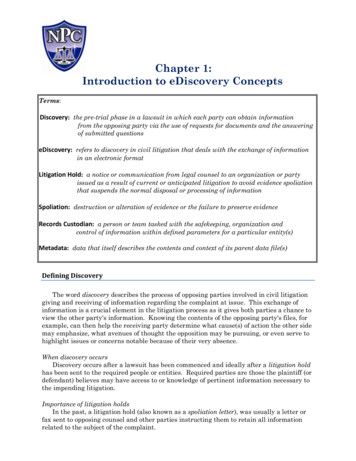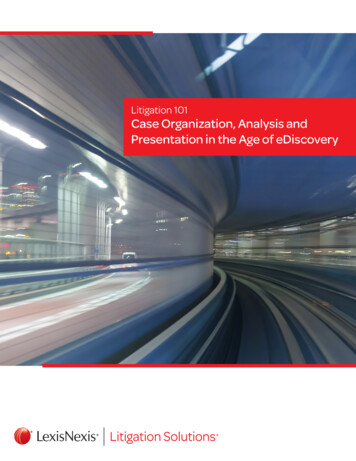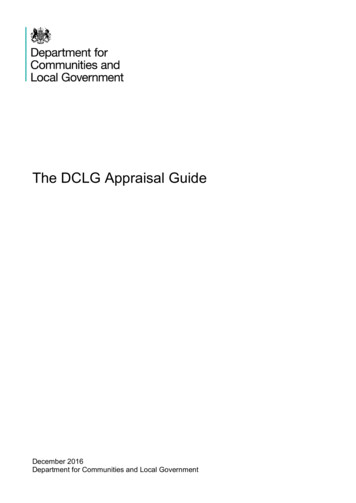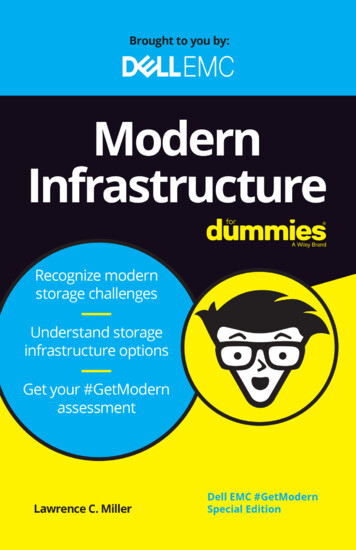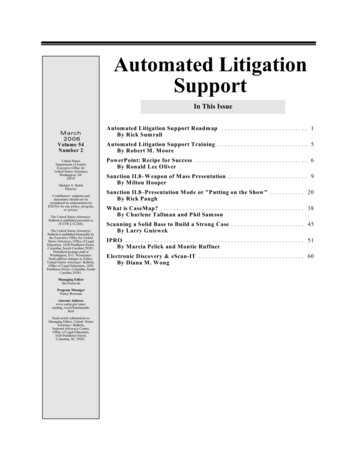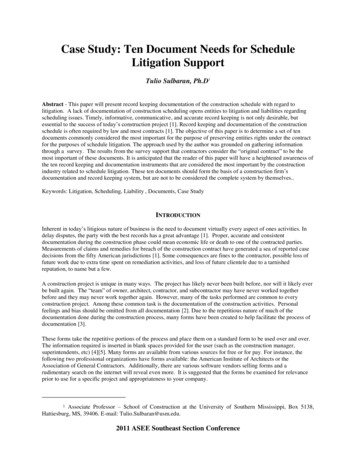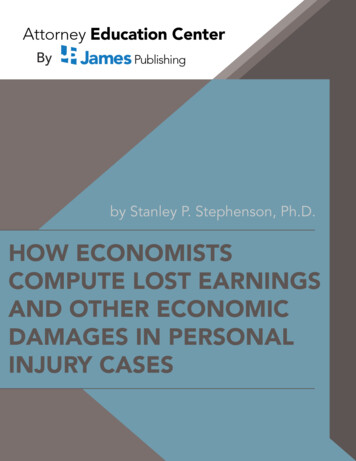
Transcription
How Economists Compute LostEarnings and Other EconomicDamages in Personal Injury CasesByStanley P. Stephenson, Ph.D.Introduction- Key Issues in Damages Assessment- Framework for AnalysisDiscounting- Deriving Future and Present Values- Impact of Different Discount Rate- Impact of Different Earnings Growth Rate- Inflation- Changing Payment PeriodsDetermining and Measuring Base Earnings- Standard of Earnings Measure- Measuring Base Earnings- Adjustments to Base Earnings- Special CircumstancesFringe Benefits- What to Include- How to ValueMitigation and Loss Period- Estimating Loss Period Length- Methodological Choices- Years to Final SeparationCommercial Losses Arising From Personal Injury or Death- Damages as Lost Profits- Damages as Lost Business Value- Choice of Discount Rate1
Adjustments to Basic Damages Model- Household Production Value- Personal Consumption AdjustmentMedical Care and Rehabilitation Damages- Issues Economist Needs to Address- How to Estimate Future Medical Care CostsIncome Taxes and Damage AwardsCopyright 2013 James Publishing800-440-47802
I.Introduction§1:01 Economics OverviewEconomics was at one time called “the dismal science,” a reaction by Thomas Carlyle tothe theories of Parson Malthus suggesting cycles of poverty and starvation as foodproduction failed to keep up with population growth. Economic graduate students usedto wonder if that was really the source of the dismal science term or a reaction toMalthus’ policy suggestion of abstinence as a solution to the problem. Advances inproductivity have forestalled Malthus’ predictions (1798).Today’s economists are still concerned however with issues of value and distribution andhow market forces operate to price scarce resources like labor, land, machines and morerecently information and time. The field is generally divided into two areas:macroeconomics and microeconomics. Macroeconomics is concerned with large flowsof spending by consumers, governments, and companies; trade; price stability; economicgrowth; and employment and capital utilization. Microeconomics is concerned, as thename suggests, with economic decisions made by individuals and firms and associatedoutcomes like individual earnings and company profits. Economists who estimateeconomic damages do so primarily with the analytical methods and data found inmicroeconomics. Economic thinking is key.A story may help understanding. Apparently in 18th century Germany, it was common forarmies passing through the villages on their way to battle to acquire beef by paying thefarmer the market rate for a cow. The market rate was determined by the forces of supplyand demand to set a going sales price for the cow, an asset to the farmer. Conscriptionwas also common in which case the army would draft the men of the farms, pay them alow stipend, and if, they were killed, pay the family a sufficient sum to cover burialexpenses.From an economic thinking point of view, the two practices were inconsistent. For theone resource, the cow, the market price would reflect the future stream of income frommilk, net of upkeep cost, and perhaps a terminal value for sale as beef. For the draftee,the army pay was below what the individual could earn as a farmer, and if killed, thepromised burial costs were less than the future stream of earnings the draftee could haveexpected, less maintenance for shelter, food, clothing, and medicine.§1:02 Role of the Economist in DamagesLeaving aside any comparisons regarding the compensation of soldiers then and now, thepoint is that economists today view individuals as assets that can generate a stream ofcurrent and future earnings. Some factors like age, education/training, geographiclocation, gender, race, occupation, industry, union membership, and health can impactthis future stream. So too can the individual’s injury or death. If the individual owns orplays a significant role in a company, then the injury or death can impact future companyprofits or even the entire company value. This is the arena of the forensic economist.3
The main goal of the damages expert in personal injury, wrongful death, and similartypes of tort cases, is to calculate damages as a lump sum today that exactly matches theeconomic losses the plaintiff has incurred in the past and will reasonably incur in thefuture. This assessment is made as of the trial date, which implies several challenges.First, because future damages are unknown, how does the expert provide an estimate thatis economically reasonable or economically likely, meaning better than a fifty percentchance of taking place in the future? This is not the same thing as saying there is afifty/fifty chance of being correct or incorrect; in fact, the damages expert cannot opineregarding the probability of his/her analysis being correct without undermining his/hercredibility and facing possible impeachment as an expert witness. Second, what sort ofdata is needed to make a damages argument? Third, how does the economist deal withinflation, union status, partial year payments, fringe benefits, and a host of related issues?Fourth, how does the expert compute an appropriate lump sum at trial date?The role of the economic expert is to assist the trier of fact and to be objective inestimating economic damages. This means that the expert’s opinions should not varydepending on whether the expert is working from the plaintiff or defense side, an idealthat unfortunately sometimes varies in practice. Experts are paid time and expenses anddo not share in the financial awards of the case. That is unethical and may even be illegalin some venues.§1:03 Choosing a Damages ExpertAttorneys typically choose an economist, accountant, or finance expert in estimatingdamages. Regardless of who is chosen, the expert should have knowledge and experiencethat uniquely qualifies him/her as a specialist or expert in the field. This typically meansholding graduate degrees such as a Ph.D. or D.B.A. (Doctor of Business Administration),or a CPA or MBA. In addition to advanced degrees, the expert’s credentials may alsoinclude memberships in professional societies; a relevant publication record, especially inpeer-reviewed journals; academic positions; and past experience in providing expertwitness testimony. This last issue is most important because credibility as a witness iscrucial to courtroom success and that largely depends on demeanor, dress, and non-verbalbehavior rather than a long curriculum vitae or use of clever words or knowledge oftechnical jargon. This is not to say that credentials and an excellent analysis areunimportant, but as these are becoming increasingly common, skill in courtroompresentation may be the critical element.As to the question of which damages expert to use, economist, accountant, financeexpert, or some other discipline, the answer depends on the nature of the case and mayinvolve hiring more than one expert. Economists are typically retained when the caseinvolves lost wages or income, which involves dealing with economic data onoccupations, industries and the use of statistics, forecasts and economic analysis. Theyare also used in questions involving market assessments and commercial cases involvingbusiness disruption, intellectual property infringement, and antitrust issues. Accountantsand financial experts typically get involved in commercial matters involving analysis of4
company financial records and tax issues. On large and complex commercial cases, it isnot unusual for an analysis team to include input from two or even three disciplines.§1:04 Key Issues in Damages AssessmentTo reach an assessment of loss, the damages expert finds it useful to construct a modelthat contrasts what would have been a likely economic outcome, such as a stream offuture earnings or income, with what is likely to happen due to some event causing anearnings or income disruption. The disruption may have arisen from an event like anaccident causing an injury or death, a contract dispute, or employment termination; ingeneral, some event occurs that leads to a claimed loss of financial benefits.For example, “but-for” the explosion and fire one night in a dental lab located on theground floor of a two-story office building that was totally destroyed, the dentist ownerof the building presumably would have continued to receive an uninterrupted stream offuture income from his practice and rent from building tenants. Similarly, “but-for” theairplane crash of Korean flight 007, nearly 270 passengers and crew who died wouldhave had future earnings and incomes. In the first example, the income loss is temporaryand can be partially mitigated, or offset, by temporarily re-locating the dental practiceuntil the original office building is re-built. In the second example, the loss is permanentwith no mitigation possible. The common task for the damages expert in each instance isto assess predicted earnings and income streams vis a vis past and predicted actualearnings or income.§1:05 Framework for AnalysisDamages can be addressed by answering a series of six supporting questions.1. Base Earnings: What were earnings (or income) just before the limiting eventtook place? (Note: “earnings” will be used below to represent either earning orincome.)2. Fringe Benefits: Similarly, what were fringe benefits just before the limitingevent? Sometimes this is included in ‘compensation.’3. Earnings Growth: What rate of growth in earnings was expected “but-for” theevent that limited earnings?4. Loss Duration: How long are earnings expected to be limited?5. Mitigation: During the loss duration period, can any earnings reasonably beexpected in spite of the limiting event?6. Discounting: What is the value of lost earnings at the trial date? Lost earnings arethe sum of net lost earnings for the time after the event to the trial date, called the“past damages” and “future damages,” meaning the net lost earnings for the lossduration period after the trial.The table below is another way to express economic damages. Total damages arecomprised of past and future damages, meaning “but-for” past and future earnings, lessmitigation, and adjusted for prejudgment interest and discounting if the venue permitssuch adjustment. Most damages assessments include these components. [“Summary” in5
Computing Economic Loss in Cases of Wrongful Death, Elizabeth M. King, James P.Smith, RAND, Santa Monica, Ca, 1988, at pp v-xvi.“Reference Guide for ValuingEconomic Loss in Personal Injury, Wrongful Death and Survival Actions”, ExpertEconomic Testimony: Reference Guides for Judges and Attorneys, Thomas R. Ireland,Stephen M. Horner and James D. Rodgers, Tucson, AZ: Lawyers & Judges PublishingCo., Inc., 1998, at pp 1-107. “Estimating Damages in Personal Injury and WrongfulDeath Cases”, Michael L. Brookshire, Charles W. deSeve, and Frank L. Slesnick, inLitigation Economics, Patrick A. Gaughan and Robert J. Thornton, eds., Greenwich, CT:JAI Press Inc., 1993, at pp.15-38. “Reference Guide on Estimation of Economic Lossesin Damages Awards”, Robert E. Hall and Victoria A. Lazear, in Reference Manual onScientific Evidence, West Group, St. Paul, 2000.]A key premise throughout this discussion is that liability has already been established.The defendant did something harmful or caused something harmful to happen which hasreduced the plaintiff’s future earnings or a company’s profits or value.Damages ComponentsPast Damages(damagesbefore trial) "But-for"earningsafter theevent beforetrial"But-for"earningsafter the trial-ActualEarningsbeforetrial PrejudgmentInterest (ifapplicable)-ActualEarningsafter trial Discounting(ifapplicable) FutureDamages(damages aftertrial) TOTALDAMAGESA typical presentation on economic damages begins left to right using these damagescomponents. In this chapter, however, we begin with discounting mainly because itaffords a convenient framework of the analytical steps involved in estimating damagesand to a lesser extent it is the one area which attorneys generally find most daunting, solet’s deal with it first.6
II.DiscountingA. Overview§2:01 Deriving Future and Present ValuesFuture economic damages are expressed as the present value of future lost earnings,sometimes referred to as discounted future losses. The key issue is that dollars today anddollars in the future have different values. Specifically, most individuals, if offered thechoice of a 1.00 today and a 1.00 at the end of one year, would choose the dollar todaybecause it is more certain (less risk of nonpayment) and because interest rates are abovezero (positive investment opportunities exist).Let’s say interest rates are 5.00% per year; this means we could invest the 1.00 todayand at the end of a year have the original 1.00 plus 0.05 in interest, or 1.05 in oneyear, not just 1.00 we have now. This process is called accumulation and asks “What isthe future value (FV) of some amount of money (e.g. 1.00) invested today for a certainperiod of time with a known rate of interest (e.g. 5.0%)?” Discounting is related toaccumulation but works in the opposite direction and asks “What is the present value(PV) of some money promised in the future after a period of time?” As withaccumulation, interest plays a key role in discounting.§2:02 AccumulationWe can express these ideas as follows: Present Value (PV), Future Value (FV), andInterest Rate, which we refer to as a discount rate, r, when computing present values.To use a simple example, let’s assume we have 1.00 now, thus the PV is 1.00 andfurther assume the Interest Rate (r) is 0.05. We solve for the Future Value (FV) asfollows: FV PV * (1 r), or FV 1.00*(1 .05) 1.05. At the end of one year, giventhe values shown, the future value of 1.00 today is 1.05. In general, with each addedyear in the future, FV grows by a factor of (1 r), or (1 0.05). That is, FV of 1.00today after 2 years if r 5% is FV 1.00*(1 .05)*(1 .05) 1.1025. In general, a FVwhich is t years in the future would be equal toEquation (1) FV PV*(1 r) twhere t 1 n future years or periods.§2:03 DiscountingHaving solved for the future value at various times of 1.00, we can ask a relatedquestion; namely, “What is the present value (PV), the value now, of 1.00 to bedelivered in the future?” To answer this question, we re-arrange the terms in equation (1):Equation (2) PV (FVt * (1/ (1 r) t), where r is the interest (discount) ratet 0, 1, 2, n, is years in the future(1/ (1 r) t) is the “discount factor”for each year t7
Using the example where t represents year one, we find PV 1 * (1/ (1 .05)) 0.9524.That is, the value today of 1.00 to be received one year in the future is about 95 cents.The purchasing power of 1.00 after one year is below 1.00 today due to fact there are 5percent investment opportunities available. To prove this, we may use Equation (1) tonote that the FV of 0.9524 today with interest of 5 percent is 0.9524 * (1 .05) is 1.00002, which is 1.00 except for rounding.To compute the discounted present value of a stream of future earnings, we repeatedlycompute the elements in Equation (2), one for each year, and sum the total. The Greekletter sigma, , mathematically means to add up each element in a series. Thus we canshow the PV for an entire stream of future earnings as follows:Equation (3) PV (FVt * (1/ (1 r) t), where FV is future earnings in period t[“How to Calculate Present Values”, Principles of Corporate Finance, 4th edition,Richard A. Brealey and Stewart C. Myers, New York, NY: McGraw-Hill, Inc., 1991, atpp 29-45.]§2:04 Discounted Economic Damages ExampleWe relate the discussion on discounting to a litigation context by offering an example ofeconomic damages in Table 1.Table 1. Computation of Economic Damages ExampleAssuming Loss Period is 5 Years and Interest Is 5 Percent{2}{3}{4}{5}{1}YearAge Lost Pay DiscountTimeRatePeriodPastTrial 231 10,0005%-11.05 10,500201320142015201632333435 5%5%5%5%012310.952380950.907029480.8638376 12,000 14,286 18,141 19,868 74,79512,00015,00020,00023,000 80,000The data offered in Table 1 are facts assumed for illustrative purposes. Let’s say anindividual, Sue Jones, was injured in an accident in 2012 and she was unable to work atall for four years after which she was able to resume her career with no residual effectson her future earnings growth. Her income loss in 2012 was 10,000. Trial is set forJanuary 1, 2013. A damages expert is asked to compute her past and future earningsloss.11For now, to keep this example simple, we assume total work loss in 2012 and for the following four years,2013-2016. Real events and trial rarely happen on the first or last day of a year and a individual may bepartially rather than totally unable to work. These factors complicate but do not change the essentials.8
Past lost earnings might be stated as simply 10,000; however, the logic of discountingsuggests that because she didn’t have this sum after the accident, she sacrificed not onlythat amount but also interest she could have earned. Some jurisdictions allow this as partof damages and it is referred to as “prejudgment interest”. With a 5% prejudgmentinterest rate, the Discount Factor in Col. {6} is computed by the formula for FV of 1.00.In this way, past lost earnings are computed as 10,500. Let’s assume we are in ajurisdiction that allows such. (If not, then the discount factor for 2012 is 1.0 and PresentValue is 10,000.)The damages expert has been told, presumably by other experts such as a medical expertand/or a vocational rehabilitation expert, that the loss period is four years, until the end of2016. Research also determines that a reasonable schedule of future annual lost earningsis shown in Table 1; Col. {3} and 5% is an appropriate discount rate. We are now readyto compute future lost earnings using the formula in Equation (3). We do this on a yearby year basis as follows: For 2013, because pay is received on the first of the year and the trial dateis January 1, there is no discounting. Losses for 2013 are exactly 12,000,assuming the injured party would have gotten a raise in 2013 of 2,000over 2012 pay rate.For 2014, future losses need to be discounted into present values as ofJanuary 1, 2013. This is done by multiplying 15,000 by the discountfactor, 0.95238 to obtain 14,286.For years 2015 and 2016 the same process is followed as for 2014.The discounted present value of past and future earnings losses for Sue Jones, expressedin January 1, 2013 dollars, is 74,795. This is the exact total needed to pay Ms. Joneseach year, the lost earnings shown in Col {3} with nothing left over. The reason it is lessthan 80,000 is because during the four year loss period in which “payments” would havebeen made, it is assumed that the remaining balance each year would earn a 5% annualreturn or interest payment.B. Impact on Discounted Future Earnings of Different“Facts”§2:05 OverviewIn order to estimate economic damages, we made certain assumptions in the context ofthis hypothetical case. We then estimated damages by using these assumptions inEquations (1) and (3). At this point, we re-examine these assumptions in terms of theimpact on discounted damages of a different set of facts; namely, we consider a differentdiscount rate, alternative growth rate in earnings, and add inflation to the analysis. Inaddition, we consider the impact on discounted earnings of some state laws that limit9
computation of discounted earnings loss. As we review each of these issues, we will alsonote data sources needed to make the analysis credible.1. Impact of a Different Discount Rate§2:06 Effect of Lower Discount RateIn Table 2, we have made only one change from Table 1; namely, the discount rate ischanged to 2%, not 5%. The result is that economic damages are greater than before by 3,008 dollars ( 77,803- 74,795).The basis for this result comes exactly fromEquations (1) for FV for past damages which are now lower, because 2% 5%, andEquation (2 or 3) for the present value of future damages which are now greater for thesame reason. PV of future damages must be greater with a lower discount rate becausethe discount rate is in the denominator of Equations (2) and (3). This main point bearsrepeating because it is very important: a lower discount rate generates greater discountedpresent values of future earnings and vice versa.Table 2. Computation of Economic DamagesExampleAssuming Loss Period is Five Years and Interest Is Two Percent{1}{2}{3}{4}{5}{6}Discount TimeDiscountYear re201320142015201632333435Total {7}10,0002%-11.02 10,200 12,000 15,000 20,000 23,000 80,0002%2%2%2%012310.980392160.961168780.94232233 12,000 14,706 19,223 21,673 77,803The technical role of discounting is to express future dollars in value today. Given itsimportance in computing discounted future earnings, what criteria should a damagesexpert use in choice of a discount rate?§2:07 Principal Criteria in Choice of Discount RateIn a litigation context, a discount rate should be chosen that enables interest to offsetfuture payments once the award is invested but not so high a bond rate as to risk default.There is considerable debate among forensic economists as to how best to make thischoice. The following issues typically arise in these debates: Minimize default risk by choosing a combination of short term, medium term, andlong term US Treasury bonds with one set to mature each year of the expectedloss period. Minimize default risk and inflation risk by choosing very short term US Treasurynotes and assume the plaintiff reinvests the principal every 90 days. US10
government Treasury bills of very short duration have the least risk of default andreduce the risk of unanticipated inflation. In 2012 the average yield on 3-monthTreasury bonds was 0.09%. (vs. 11.09% in 1982.)Choose a US Treasury bond rate with maturity equal to the length of loss period.To clarify this last point, e.g., the bond-term-match-loss-duration argument for a 20-yearloss, one should choose a 20-year bond. For 2012, the 20-year US Treasury constantmaturity bond rate was 2.54%. A refinement of this argument for a 20-year loss period isnot to select a fixed discount rate for the entire period but to choose a one-year rate forthe first year, and so forth, up to a 20-year rate for the 20th year. The computations are thesame as offered in Tables 1 and 2, but the discount rate varies.A recent survey of forensic economists [see Frank Slesnick, Michael L. Brookshire,Michael R. Luthy “A 2012 Survey of Forensic Economists, Their Methods, Estimatesand Perspectives” in Litigation Economics Review, Vol.24 No.1: 67-99] providedadditional information on criteria used by forensic economists in selecting a discountrate: Q. Which maturity length of bonds would you use if the plaintiff has 30 years offuture work life expected? Ans. Short: 10.3%, Intermediate: 13.9%, Long: 30.9%;Mixed 32.1%; Other 12.7%.Q. Current vs. historical rates: When determining interest rate for PV purposesover a 30-year loss period, which do you use? Ans. Historical Average: 44.6%,Current Rates: 38.6%, Other 16.8%.In general, the longer the maturity, the greater the bond rate, which enables more interestto be generated, and, as we saw from Equations (2) and (3), lowers the PV of futuredamages. How this point is handled in practice is something cross-examining attorneysshould note carefully because of the efficacy of a small change in discount rate in causinga significant impact on PV estimation.If the economist uses some historical average an important question is how far back inhistory to go. Unfortunately, there is no generally accepted guideline. The main issue iswhat will be a reasonable future yield on bonds that are low default and inflation risk yetprovide interest to cover future payment draws. In conclusion, choice of discount rate cangreatly impact discounted future earnings; the expert should exercise care in choosing abond yield and be prepared to provide evidence supporting the choice. [See “Risk,Discounting, and the Present Value of Future Earnings”, Brian C. Brush, in Journal ofForensic Economics, Volume XVI, No 3, Fall 2003, at pp.263-274.]§2:08 Other Criteria in Choice of Discount RateIndividual circumstance in the stream of lost earnings is another criterion for the expert toconsider, especially if the lost earnings stream historically had risk elements. Forexample, if the plaintiff’s past earnings were derived in part from stock options, then thisshould call for an analysis of the company’s stock price changes and require a discountrate that reflects greater risk.11
Similarly, if the injured person owned a company and derived earnings in the form ofsalary and profits, then the expert should select a discount rate that reflects the weightedaverage cost of capital (WACC) of the enterprise to match the risk facing the plaintiff’spast earnings stream. In such cases, for example, using the capital asset pricing model(CAPM), the expert might reasonably choose a discount rate of 10%, 15%, or evenmore.2§2:09 Final Points of Caution in Choice of Discount RateFirst, the role of the expert is to assist the trier of fact, not to become an advocate for oneside or another. As we just demonstrated, choosing a very low discount rate can increasethe damages estimate considerably. In Tables 1 and 2, we saw that choosing a 2% vs. a5% discount rate increased total damages by 3,008, more than 4% difference. While theforensic economist has the capacity to alter damages via subjectively choosing a clientfavoring discount rate, it is hoped that does not happen.Second, whatever choice is made, the expert needs to justify his/her selection of adiscount rate. If records are produced of “flip-flopping” by the expert in discount ratechoice, the expert’s credibility will be sharply damaged.Third, one need not just use federal bonds. Some experts seeking a balanced view ofdefault risk and interest yield use municipal bonds yields as a source for a discount rate.[See Federal Reserve Bank Web, http://www.federalreserve.gov/releases/.]2. Impact of Different Earnings Growth Rate§2:10 Actual Earnings or Statistical Averages?In Table 1, Col {3}, only past earnings, 10,000, is known. In future years, earnings areforecast by the expert. This sets up several choices. Does the expert rely on past actualearnings of the individual and make a forecast or does the expert instead rely onpublished statistics that show earnings average by occupation, industry, full-time/yearround employment, education, gender, race, and other wage-impacting factors that arelikely to affect the earnings capacity of the injured person. If past actual earnings historyis not available, as in the case of a child, a student, or episodic worker, then an earningscapacity approach might be preferred.Care should be exercised regardless of which approach is used. For example, if theperson had worked in San Jose, California as an engineer developing software in a hightech firm in the period from 1998 to 2000 and was wrongfully terminated in 2001, itwould be questionable to merely extrapolate past earnings into the future given the factthat the 2001-2004 period was marked by relatively high unemployment for software2See Shannon Pratt and Roger Grabowski, The Cost of Capital, 4th ed., John Wiley & Sons, 2010.12
engineers in high tech firms in the San Jose area. Instead, an expected earnings approachwould be more reasonable in which the factors listed above were considered in additionto life cycle, productivity, and business cycle effects.In Tables 1 and 2, earnings growth shown in Col. {3} showed the following percentagegrowth from year to year.PeriodPercent ChangeFrom 2012 to 201320% ( (12,000-10,000)/10,000*100)From 2013 to 201425%From 2014 to 201533%From 2015 to 201615%Average Annual Change23.25 PercentWhile hypothetical, these data should raise serious questions to the reader. Specifically,what evidence supports an assumed average rate of future annual earnings growth ofmore than 23% per year? If the expert cannot provide this evidence in a convincingmanner, then his/her credibility is seriously undermined. The expert may claim that pastactual earnings growth or future contracts made these rates reasonable, but that is astretch if not supported by data. An opposing attorney might point out that the US LaborDepartment, Bureau of Labor Statistics, publishes rates of compensation growth byoccupation, industry, and location in its Employment Cost Index (ECI). For the periodfrom 2001 to 2nd Quarter 2012, the ECI for all workers, private industry, totalcompensation was at most 4.0% per year and for years 2009-2012 was at most 2.2%,rates well below 23.25%. [See Web Site for Bureau of Labor Statistics,http://www.bls.gov/bls/wages.htm .]§2:11 Fixed or VariableIt should be obvious that choosing a higher (or lower) rate of earnings growth, if nothingelse changes, will raise (or lower) the computation of economic damages. Growth ratesmay be fixed or variable. The example shown in Tables 1 and 2 allowed varying rates ofearnings growth. What is frequently assumed by testifying damages experts, however, isa fixed rate of future earnings growth for each time period in the overall loss duration. Ina personal injury or death case, this may or may not be appropriate depending on when ina person’s earnings history the earnings-limiting event takes place.§2:12 Typical Age-Earnings ProfileThe figure below shows a typical age-earnings profile for an expected work life without aperiod of disruption. The figure shape is generally in accordance with cross-sectional USCensus earnings data, meaning data for a single moment in time, for a wide variety ofindividuals of varying education, gender, or race. Those with more education tend to startwork at an older age, show a steeper rate of earnings g
Attorneys typically choose an economist, accountant, or finance expert in estimating damages. Regardless of who is chosen, the expert should have knowledge and experience that uniquely qualifies him/her as a specialist or expert in the field. This typically means holding graduate

